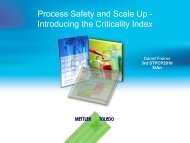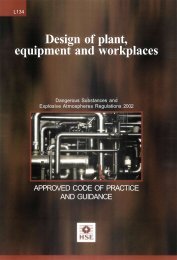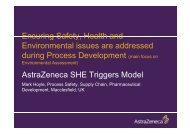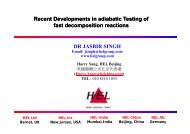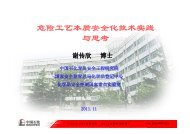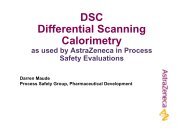Designing and operating safe chemical reaction processes HSG143
Designing and operating safe chemical reaction processes HSG143
Designing and operating safe chemical reaction processes HSG143
You also want an ePaper? Increase the reach of your titles
YUMPU automatically turns print PDFs into web optimized ePapers that Google loves.
Health <strong>and</strong> SafetyExecutiveGlossaryAccelerating rate calorimeter (ARCTM): A type of adiabatic calorimeter.Accumulation: A build-up of unreacted materials in a semi-batch or continuousreactor.Adiabatic: No heat transfer occurs to or from the environment surrounding thesample, including the sample container.Adiabatic temperature rise: The increase in temperature of a reacting mixture asa result of exothermic <strong>chemical</strong> <strong>reaction</strong>, when there is no heat transfer to or fromthe environment.ARC TM : see accelerating rate calorimeter.Autocatalysis: The increase of the rate of <strong>reaction</strong> due to the catalysing effect ofthe <strong>reaction</strong> products.Autoignition temperature: The minimum temperature at which a material willignite spontaneously under specified test conditions. It can also be referred to asthe minimum ignition temperature.Basis of <strong>safe</strong>ty: The combination of measures relied upon to ensure <strong>safe</strong>ty. Thebasis of <strong>safe</strong>ty for a reactor highlights those aspects of the design <strong>and</strong> operation(hardware, protective systems <strong>and</strong> procedures) that are <strong>safe</strong>ty critical. The basis of<strong>safe</strong>ty can only be selected once all the significant hazards have been identified<strong>and</strong> evaluated.Batch process: An operation in which all the reactants including any solvent areadded to a reactor at the start of a <strong>reaction</strong>.Batch reactor: Reactor in which all reactants <strong>and</strong> solvents are introduced beforesetting the <strong>reaction</strong> conditions. Products are only taken from the reactor uponconclusion of the <strong>reaction</strong> process.Bubbly flow: A two-phase flow regime in which small discrete bubbles existwithin a liquid.Calorimeter: See <strong>reaction</strong> calorimeter.Choked flow: The maximum flow rate of a compressible fluid (gas or two-phase)for a given upstream pressure.Churn-turbulent flow: A two-phase flow regime in which large bubbles existwithin a liquid.Continuous reactors: Reactors that are characterised by a continuous flow ofreactants into, <strong>and</strong> products from, the reactor system.Continuous stirred tank reactor (CSTR): A tank reactor in which the contentsare stirred by an agitator to promote mixing <strong>and</strong> characterised by a continuous flowof reactants into, <strong>and</strong> products from, the <strong>reaction</strong> system.<strong>Designing</strong> <strong>and</strong> <strong>operating</strong> <strong>safe</strong> <strong>chemical</strong> <strong>reaction</strong> <strong>processes</strong> Page 60 of 64





